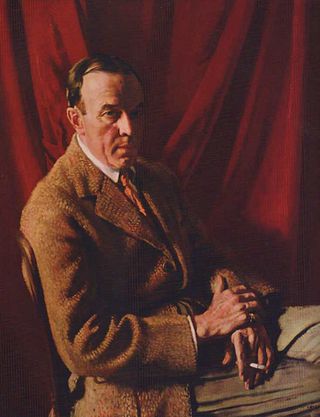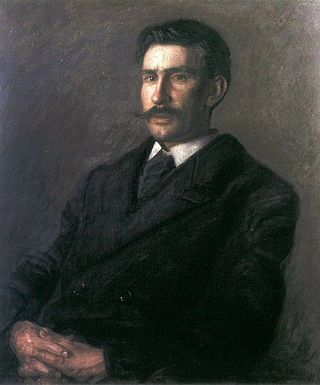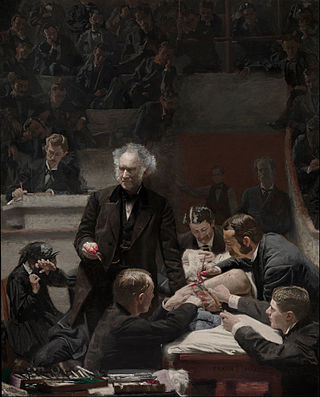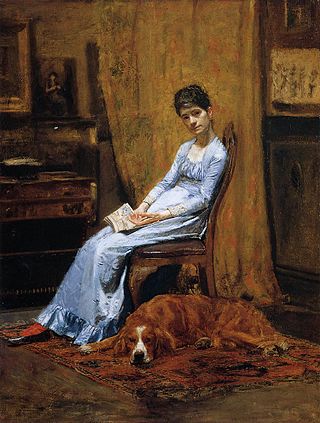
Thomas Cowperthwait Eakins was an American realist painter, photographer, sculptor, and fine arts educator. He is widely acknowledged to be one of the most important American artists.

The Pennsylvania Academy of the Fine Arts (PAFA) is a museum and private art school in Philadelphia, Pennsylvania. It was founded in 1805 and is the first and oldest art museum and art school in the United States.

Arcadia refers to a vision of pastoralism and harmony with nature. The term is derived from the Greek province of the same name which dates to antiquity; the province's mountainous topography and sparse population of pastoralists later caused the word Arcadia to develop into a poetic byword for an idyllic vision of unspoiled wilderness. Arcadia is a poetic term associated with bountiful natural splendor and harmony. The 'Garden' is often inhabited by shepherds. The concept also figures in Renaissance mythology. Although commonly thought of as being in line with Utopian ideals, Arcadia differs from that tradition in that it is more often specifically regarded as unattainable. Furthermore, it is seen as a lost, Edenic form of life, contrasting to the progressive nature of Utopian desires.

Stephen Carlton Clark was an American art collector, businessman, newspaper publisher and philanthropist. He founded the Baseball Hall of Fame in Cooperstown, New York.

Edward Willis Redfield was an American Impressionist landscape painter and member of the art colony at New Hope, Pennsylvania. He is best known today for his impressionist scenes of the New Hope area, often depicting the snow-covered countryside. He also spent his summers on Boothbay Harbor, Maine, where he interpreted the local coastline. He frequently painted Maine's Monhegan Island.

The Gross Clinic or The Clinic of Dr. Gross is an 1875 painting by American artist Thomas Eakins. It is oil on canvas and measures 8 feet (240 cm) by 6.5 feet (200 cm).

The Gulf Stream is an 1899 oil painting by Winslow Homer. It shows a man in a small dismasted rudderless fishing boat struggling against the waves of the sea, and was the artist's statement on a theme that had interested him for more than a decade. Homer vacationed often in Florida, Cuba, and the Caribbean.

Elizabeth Shippen Green was an American illustrator. She illustrated children's books and worked for publications such as The Ladies' Home Journal, The Saturday Evening Post and Harper's Magazine.

The Waterseller of Seville is the title of three paintings by Spanish artist Diego Velázquez, dating from 1618–1622. The original version is considered to be among the finest works of the painter's Seville period and is displayed in the Wellington Collection of Apsley House. The original version was painted by Velázquez when he was in his late teens or early twenties. Looking at this painting, there is an older man, a young boy, and a bystander in the background. The old man is handing the young boy a glass of water but, they never look at each other, nor do they make eye contact with the viewer.

Thomas Pollock Anshutz was an American painter and teacher. Known for his portraiture and genre scenes, Anshutz was a co-founder of The Darby School. One of Thomas Eakins's most prominent students, he succeeded Eakins as director of drawing and painting classes at the Pennsylvania Academy of Fine Arts.

Max Schmitt in a Single Scull is an 1871 oil-on-canvas painting by the American artist Thomas Eakins, Goodrich catalogue #44. It is in the permanent collection of the Metropolitan Museum of Art. Set on the Schuylkill River in Philadelphia, Pennsylvania, it celebrates Eakins's friend Max Schmitt's victory in the October 5, 1870, single sculls competition.

The Swimming Hole is an 1884–85 painting by the American artist Thomas Eakins (1844–1916), Goodrich catalog #190, in the collection of the Amon Carter Museum of American Art in Fort Worth, Texas. Executed in oil on canvas, it depicts six men swimming naked in a lake, and is considered a masterpiece of American painting. According to art historian Doreen Bolger it is "perhaps Eakins' most accomplished rendition of the nude figure", and has been called "the most finely designed of all his outdoor pictures". Since the Renaissance, the human body has been considered both the basis of artists' training and the most challenging subject to depict in art, and the nude was the centerpiece of Eakins' teaching program at the Pennsylvania Academy of the Fine Arts. For Eakins, this picture was an opportunity to display his mastery of the human form.

The Agnew Clinic is an 1889 oil painting by American artist Thomas Eakins. It was commissioned to honor anatomist and surgeon David Hayes Agnew, on his retirement from teaching at the University of Pennsylvania.

The Thinker: Portrait of Louis N. Kenton is an oil painting of 1900 by the American artist Thomas Eakins. It is a depiction of the artist's brother-in-law, Louis N. Kenton (1865-1947), and it has been called "one of Eakins's most memorable portraits". The painting is one of a series of life size standing male portraits painted late in Eakins's career.

Susan Hannah Eakins was an American painter and photographer. Her works were first shown at the Pennsylvania Academy of the Fine Arts, where she was a student. She won the Mary Smith Prize there in 1879 and the Charles Toppan prize in 1882.
Art Students' League of Philadelphia was a short-lived, co-operative art school formed in reaction to Thomas Eakins's February 1886 forced-resignation from the Pennsylvania Academy of the Fine Arts. Eakins taught without pay at ASL from 1886 until the school's dissolution in early 1893.

The Ironworker's Noontime is an 1880 painting by the American painter Thomas Anshutz.

Arcadia is a c.1883 painting by Thomas Eakins, Goodrich #196. It is part of the collection of the Metropolitan Museum of Art, in New York.

The conservation-restoration of Thomas Eakins' The Gross Clinic refers to the on-going conservation-restoration treatments of American painter Thomas Eakins' 1875 painting The Gross Clinic throughout the 20th and 21st centuries. These treatments are a testament to the changing methodologies undertaken in the field of paintings conservation.


















